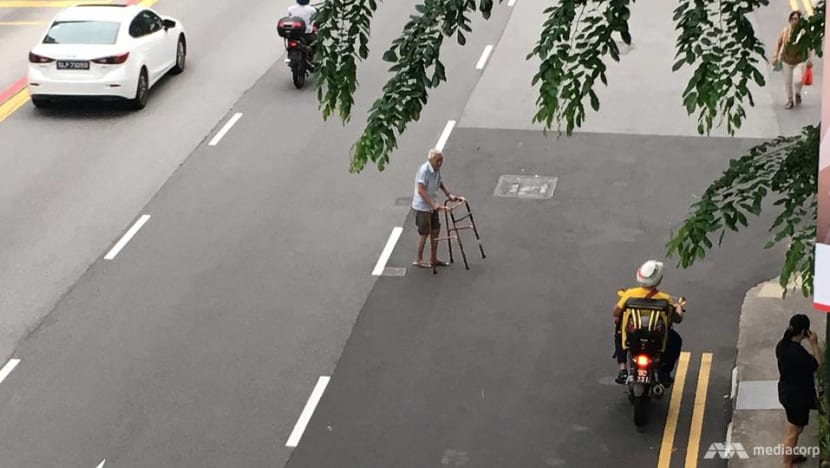Commentary: More pedestrian-friendly road features will remove the temptation to jaywalk
Well-designed infrastructure can keep pedestrians safe and reduce the burden on drivers to look out for jaywalkers, says Singapore University of Social Sciences’ Che Maohao.

An elderly man walking across North Bridge Road. (Photo: Monica Kotwani)

This audio is generated by an AI tool.
SINGAPORE: Singaporeans often lament the prevalence of bad drivers on our roads, but how often do we reflect on our own behaviour as pedestrians?
In November 2024, dashcam footage that went viral showed a woman looking at her phone and crossing a large intersection, when the light was green for vehicles. The clip captured the car barrelling into the woman, causing her to tumble to the ground.
In September 2023, a pedestrian was charged in court for injuring a motorcyclist while dashing across the road to catch a bus. The pedestrian was jaywalking, and his backpack struck the motorcyclist, who fell off his vehicle and sustained three fractures.
In accidents involving jaywalkers, it is easy to point fingers and blame reckless drivers or inattentive pedestrians. But better infrastructure is needed to enhance safety for all road users.
CURRENT STREET DESIGNS MAY INTRODUCE CONFLICT
Infrastructure can improve road safety in two ways: By reducing the conflict points between pedestrians and on-road vehicles, and reducing the severity of accidents.
For example, Orchard Road is a bustling pedestrian hub with many activities taking place on both sides of the road, increasing pedestrians’ need to cross the road often. At the same time, it serves as an arterial road with a large volume of passing traffic. This naturally leads to more interactions between pedestrians and vehicles.
The current solutions for pedestrians are underpasses at busy junctions and signalised crossings with long waiting times. However, underpasses may not be accessible to individuals with mobility challenges, and the long waiting times at crossings may encourage jaywalking.
Converting Orchard Road into a pedestrian-friendly street and diverting traffic to other roads are likely to address such conflicts. A plan to pedestrianise a 500m stretch of Orchard Road is already underway. Other examples of roads that have widened walking and cycling spaces are Bencoolen Street and a stretch of Woodlands Ring Road.
However, such conversions of Singapore roads are time-consuming and resource-intensive. Meticulous plans and multiple trials are required before an infrastructural overhaul. Therefore, these projects take years to complete and currently only take place on a small scale.
Other easier-to-implement solutions could also be adopted, for instance providing more proper crossings at busy locations such as bus stops, food courts, schools and recreational areas. Pedestrian bridges or more frequent signalised crossings could also serve as interim measures while larger projects are underway.
TRAFFIC CALMING MEASURES
It might be unrealistic to expect the number of conflict points between pedestrians and vehicles to be reduced to zero, especially in densely populated residential areas with more children and elderly residents.
With activities taking place in HDB void decks, parks, and playgrounds, residents may cross the road outside of marked crossings, which make their movements unpredictable.
Dual-lane straight roads are more commonly found in residential neighbourhoods, which can pose higher risks to residents. Such road designs, while efficient for vehicular traffic, may inadvertently prioritise speed over safety.
In these cases, traffic calming measures could significantly reduce the magnitude of conflicts and the severity of potential accidents.
In Singapore’s Silver Zones – residential areas with a high population of seniors – traffic features include narrowed lanes, deliberate curves and raised humps. These features are effective in slowing vehicles down and improving driver attentiveness.
Though the Land Transport Authority aims to establish 50 Silver Zones by 2025, these designs are currently not implemented on a universal scale. With careful planning, such infrastructure could be standardised on most local residential streets.
ROAD SAFETY IS A SHARED RESPONSIBILITY
In traffic accidents, drivers often bear more liability than pedestrians because motorists have a duty of care to other road users. Well-designed infrastructure can reduce the burden on drivers while keeping pedestrians safe at the same time.
Community engagement plays a vital role in fostering road safety. Educational workshops, feedback forums, and collaboration between urban planners and local residents can ensure that infrastructure projects address the specific needs of each community.
While education campaigns can enhance awareness and encourage responsible behaviour, they cannot entirely prevent risks. Infrastructure solutions, including traffic calming measures and pedestrian-friendly designs, are essential to complement educational efforts. Achieving safer roads requires collective action from individuals, communities and governing bodies.
Dr Che Maohao is Lecturer at the College of Interdisciplinary & Experiential Learning, Singapore University of Social Sciences (SUSS).

















